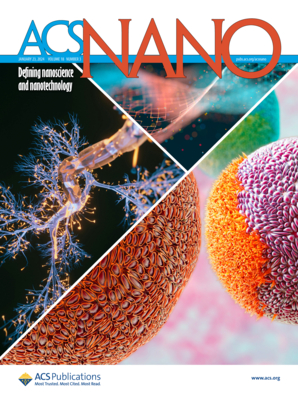Conductive Hydrogels with Topographical Geometry and Mechanical Robustness for Enhanced Peripheral Nerve Regeneration
IF 15.8
1区 材料科学
Q1 CHEMISTRY, MULTIDISCIPLINARY
引用次数: 0
Abstract
Nerve guidance conduits (NGCs) emerge as a promising solution for nerve regeneration; however, conventional NGCs fail to fulfill the requirements for peripheral nerve regeneration, which are subjected to periodical yet vigorous stretching, bending, and compression. Here, we developed a fatigue-resistant conductive hydrogel-based NGC by integrating topographical geometry, enhanced electroactivity, and superior fatigue resistance within one unit. The hydrogel, consisting of a PVA matrix with PEDOT:PSS as a conductive filler, features a topographical alignment that promotes axonal growth and achieves a fatigue threshold over 500 J/m2, making it well-suited for sciatic nerve repairing. Phase segregation of PEDOT chains enhances its electrical conductivity (>500 S/m) and mitigates the interfacial impedance mismatch, allowing for high-efficiency bioelectrical signal transmission. In vivo studies on a rat sciatic nerve injury model corroborate the accelerated peripheral nerve regeneration through improved motor function recovery and efficient electrophysiological signal transmission. These findings establish our hydrogel-based NGCs as a promising solution for high-efficiency nerve regeneration through the synergy of topographical, mechanical, and electrical engineering.

具有地形几何和机械稳健性的导电水凝胶用于增强周围神经再生
神经引导导管(NGCs)是一种很有前途的神经再生解决方案;然而,由于周围神经受到周期性的剧烈拉伸、弯曲和压迫,传统的神经干细胞不能满足周围神经再生的要求。在这里,我们开发了一种抗疲劳的导电水凝胶型NGC,将地形几何形状、增强的电活性和优异的抗疲劳性集成在一个单元中。该水凝胶由PVA基质和PEDOT:PSS作为导电填料组成,具有促进轴突生长的地形排列,并达到超过500 J/m2的疲劳阈值,使其非常适合坐骨神经修复。PEDOT链的相分离提高了其导电性(>500 S/m),减轻了界面阻抗失配,从而实现了高效的生物电信号传输。大鼠坐骨神经损伤模型的体内研究证实了通过改善运动功能恢复和有效的电生理信号传递来加速周围神经再生。这些发现表明,通过地形、机械和电气工程的协同作用,我们基于水凝胶的神经干细胞是一种很有前途的高效神经再生解决方案。
本文章由计算机程序翻译,如有差异,请以英文原文为准。
求助全文
约1分钟内获得全文
求助全文
来源期刊

ACS Nano
工程技术-材料科学:综合
CiteScore
26.00
自引率
4.10%
发文量
1627
审稿时长
1.7 months
期刊介绍:
ACS Nano, published monthly, serves as an international forum for comprehensive articles on nanoscience and nanotechnology research at the intersections of chemistry, biology, materials science, physics, and engineering. The journal fosters communication among scientists in these communities, facilitating collaboration, new research opportunities, and advancements through discoveries. ACS Nano covers synthesis, assembly, characterization, theory, and simulation of nanostructures, nanobiotechnology, nanofabrication, methods and tools for nanoscience and nanotechnology, and self- and directed-assembly. Alongside original research articles, it offers thorough reviews, perspectives on cutting-edge research, and discussions envisioning the future of nanoscience and nanotechnology.
 求助内容:
求助内容: 应助结果提醒方式:
应助结果提醒方式:


